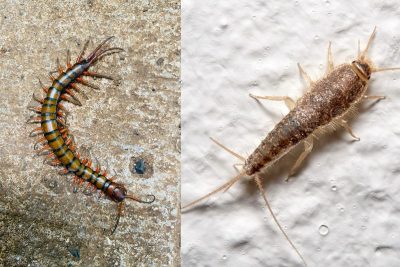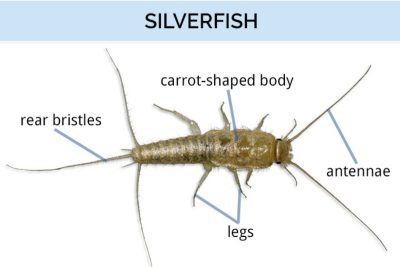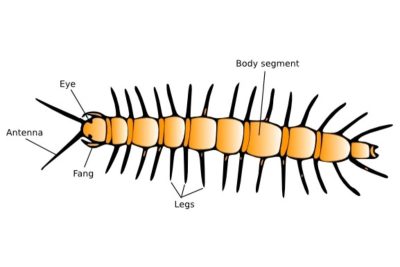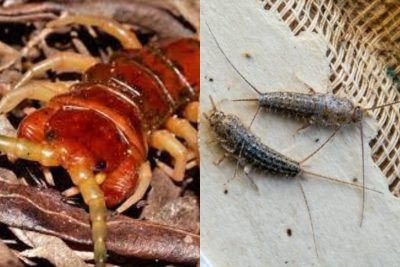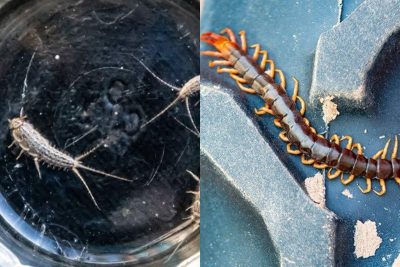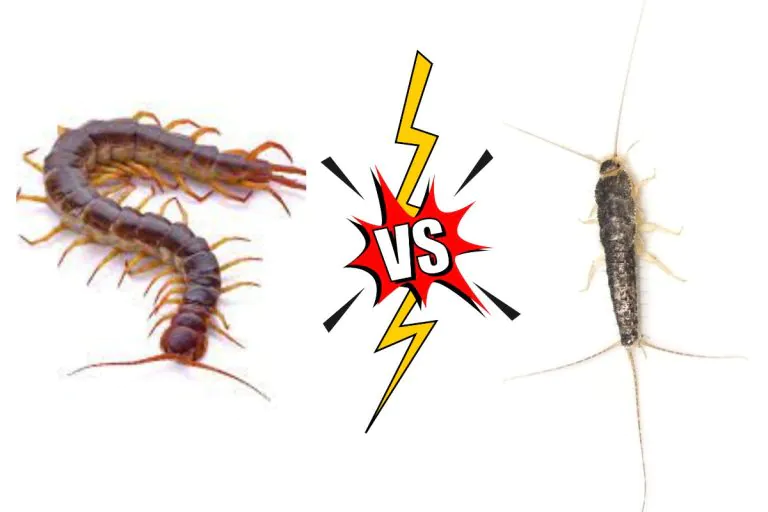
- LAST UPDATED: November 25, 2023
Having a centipede or silverfish in your house can be pretty creepy. You might see tiny insects in your house and wonder if it is a house centipede or silverfish. Many people confuse them due to their similar appearance. But many significant differences can help you easily distinguish between the two pests. This article will take you through the common differences between a centipede vs. silverfish.
Centipede vs. Silverfish: Common Differences
You can easily distinguish between a Centipede and a Silverfish with common differences, including their appearance, eating habits, habitats, and other features. We have listed the significant differences between the two pests to make it much easier and more convenient to find out if you have a centipede or silverfish in your home
Centipede | Silverfish |
|
| Size | 0.4-7 inches | 0.5-1 inches |
| Color | Yellowish-Brown body with dark bands vertically in torso | Silver or Gray (Dark Brown rarely) |
| Legs | About 30 legs | Legs About 30 legs 6 legs and 3 Appendages |
| Eating Habits | Insects | Paper, Food, Clothing, and even each other |
| Habitat | Habitat Dark Moist Places mainly in a pile of leaves or other natural debris Dark Moist Places mainly under piles or paper or cardboard containers. | Dark Moist Places mainly under piles or paper or cardboard containers. |
Legs
One of the main differences between a centipede vs. silverfish is the legs. You can distinguish between the two by looking at the legs. For example, a house centipede has almost 30 legs, whereas a silverfish has only about six legs. A silverfish is an insect that explains the six legs, whereas centipedes are arthropods closely related to insects but aren’t actual insects.
Most people get confused with the two rear legs of female centipedes, similar to what silverfish have. But centipedes have much longer legs compared to silverfish. Silverfish have three appendages that might look like legs extending from the abdomen for sensing purposes.
Body
When looking at the body, you can distinguish between a house centipede and a silverfish by looking at the color and size. Silverfish are generally small within the size range of 0.5 to 1 inch, but centipedes broadly vary in size, growing up to 7 inches; some smaller ones are just 0.4 inches long.
Centipedes are yellowish-brown in color, with dark bands running down the legs. Whereas silverfish is silver or gray, and very rarely, you might also find a dark brown coloring. No dark bands run down the torso of a silverfish, and they have horizontal segments in the body.
Habitats
It is also necessary to identify their habitat and where they are commonly found in our homes to tell the differences. Both pests thrive in moisture, mainly in areas with high humidity and warm temperatures, which might include areas like bathrooms or kitchens. Look for them in dark locations like under the sink, near the faucet, or underneath piles of leaves and debris or paper and cardboard. Since they are nocturnal, you will find them the most active at night. They mostly get into your homes when the outer surroundings dehydrate them.
Centipedes are found primarily in wood, leaves, and other wet, decomposing natural debris. They mainly feed on insects so you can find them in habitats with more insects. Whereas silverfish feed on paper and cupboards, you can find them in piles of papers, cabinets, and other containers.
Risk
Many of us wonder if Centipedes and Silverfish possess some risk or are entirely harmless. Although both have no direct threat to humans, you don’t want them near your surroundings.
Silverfish are mainly active at night and destroy your clothing, books, and food. Whereas, Centipedes don’t possess any harm to you or your property. They can bite and inject toxins that are harmful to little insects but not dangerous to humans. But if they happen to bite you, it can get somewhat painful, quite like a bee sting.
Eating Habits
Centipedes mainly feed on other insects, and if you have centipedes in your home, there might be other insects in your home too. They feed on insects like spiders, termites, roaches, and bed bugs. And Surprisingly, centipedes also feed on silverfish. So you don’t have to worry much about centipedes stealing your food.
Silverfish generally pose a threat to your food and your surroundings. They love to consume carbs and sweets. They mainly consume paper, food crumbs, natural fibers, and each other. They also eat starches and protein-rich foods like vegetables, fibers, sugars, textiles, cereals, and pet food.
Infestation
Centipedes are helpful if you have them in your home, as they eat other insects and even silverfish. They rarely reproduce and work as natural pest management, which might help you get rid of other insects to some extent. Besides that, they offer no benefits, and you are better off without them.
Although they might seem harmless, the bite can be pretty painful, and if you are allergic to them, it can also lead to severe issues.
On the other hand, silverfish infestations directly cause harm to your property, including your food, books, and clothes. Ignoring them will only lead to more destruction. If you have severe silverfish infestations, you must seek ways to eradicate them from your home.
Prevention
By now, we might have established that having a house centipede or a silverfish in our homes isn’t helpful. After going through the differences, you can find out if you have silverfish or a centipede in your home. If you already have infestations, it is best to have a pest control company at your home to eliminate pests. It is also necessary to prevent your house from silverfish or centipede infestations.
Centipedes mainly need moisture to survive and are mainly found in wet and dark areas. They also feed on insects to prevent centipedes in your homes. Since insects also attract centipedes, you need to have an inse ct-free home to keep centipedes at bay. Also, get rid of common pest nesting areas, including leaf litter, piles of wood, and other organic debris.
Silverfish mainly feed on paper and cardboard, so throw out all the excess cardboard and paper in your home and consider switching from paper to plastic containers. Use caulking to repair cracks and crevices in your home to prevent them from laying eggs.
To avoid both pests, keep your environment dry and cool, including all interiors like bathtubs, shower stalls, or other areas prone to moisture. You can also invest in a dehumidifier to make your environment dry. Only reducing indoor humidity to 60% and lower will significantly reduce the chances of infestation.
Wrapping it Up
The number of legs, eating habits, size, color, habitat, risk, and infestation separate both pests from each other. For example, if you spot one in your house, try to distinguish between them based on its physical appearance, which is the easiest way to tell the difference between them.
With this article, you can easily distinguish between centipedes and silverfish. If you find any pests in your homes, Schedule an Extermination or try different Pest Control Products to eradicate them.

